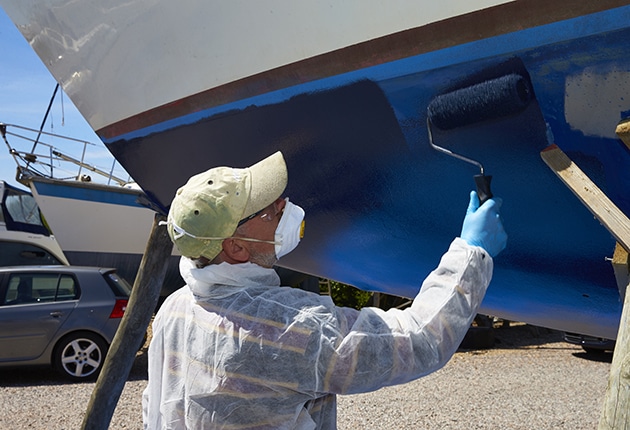
It’s time to ditch the antifouling and discover the non-toxic, low maintenance FAB Dock Docking Solution.
What is antifouling paint?
Antifoul is also known as bottom paint or antifouling bottom paint. Boaties use it to keep the nasties away – slime, weed, barnacles and other creatures that love to grow under your boat and slow it down or eat it away.
The way it works is by using a biocide, which means ‘life-destroying’. Nowadays these biocides are usually derived from copper or cuprous oxide, and they’re found in approximately 95% of bottom paints.
There are two main types of bottom paints, ablative and hard bottom.
Ablative paints erode over time, so they are known as self-polishing, soft or eroding paint. Water flow will wear the paint away over time, causing the biocide to leach out. The faster your boat speed, the faster the bottom paint erodes and the more often you must reapply it.
Hard bottom, or non-sloughing, paints usually consist of a tough epoxy coating. With these products, the paint doesn’t wear away butthe biocide does. This means that you’ll end up with no biocide and you’ll have to recoat your hull or strip it and start again.
Most recreational vessels use ablative paint, but the choice doesn’t end there. There isn’t a one-size-fits-all antifouling system because performance depends on multiple factors such as boat type, speed, water and weather.
There is another choice though – don’t use it at all.
Here are five reasons why that’s the best choice you can make.
One: Antifoul poisons the waters you boat and fish in
Most people use boats because they love oceans, lakes and rivers. They don’t set out to poison the places they love. But that word ‘biocide’ is the clue. The copper in your paint has a purpose – to stop living creatures from making a home on your boat. That means it can kill or injure them in the wider environment too. Most bottom paints contain copper and all of it eventually leaches into the water. This happens at an estimated rate of two pounds of copper per year per 30-foot boat.
Now imagine a marina with hundreds, or thousands, of boats, moored in it and you can see the problem.
Two: you may be poisoning yourself or others
Antifouling is nasty stuff. It’s not only poisonous to marine creatures, but to humans.
This is being recognised in Britain and Europe with their new Biocidal Product Regulation. This regulation will require the active ingredients in bottom paint to go through a reauthorization process. There is also talk that environmental health legislation will restrict antifouling paint use to professionals.
In the meantime, you’re advised to keep these chemicals away from your skin and eyes, not to eat or drink around them and not to breathe or swallow them. You must also be very careful when disposing of waste products, cleaning gear and so on.
Some boatyards are responding to these health risks by no longer allowing boat owners to do DIY antifouling. It’s a case of ‘leave it to the professionals’ so the marinas can be confident that standards are being followed.
Three: your boat could be slowing down
There’s some debate about this but the consensus is, yes, bottom paint can slow your boat down. If your hull has a nice slick paint job then you may not notice much effect. But if you’ve been adding a couple of coats of ablative paint every year, and the boat hasn’t had a lot of use, the layers will build up.
Plus, ablative bottom paint is designed to lose its protective properties over time. You may find slime starting to grow, or the paint job could get a bit rough. You’ll end up with drag and your boat will slow down and use more fuel.
Four: you’re doing extra maintenance
It’s the same old story – maintenance is a drag on your time and your finances. If you have bottom paint on your boat then you’ll need to take care of it. You’ll be locked into a cycle of application, cleaning and re-application.
You’ll have to take care to use the correct paint on top of an old layer. If you’re scraping that one-off, you’ll need to look after the barrier coating beneath it. It’s not a once-every-five-years job either. Many boat owners replace their antifouling annually.
There’s another cost too. More and more boatyards are banning owners from doing their own DIY job because they want to control risk factors and insurance. That means more expense for you.
Five: the choice may soon be taken out of your hands
The boating population is growing worldwide and with it the environmental impacts.
The US Environmental Protection Agency wants to limit the paints used on recreational vessels. The State of California already has. Washington State was due to ban copper in bottom paints in 2018. The ban has been delayed, but only because the alternatives were found to be toxic as well. More research is being done on the alternatives but restrictions on copper leach rates are under consideration.
European Union authorities are also concerned and Sweden and the Netherlands have partial bans.
So what’s a concerned boat owner to do?
Keep painting poison on your boat? Keep spending money on bottom paint and maintenance? Just wait until it’s banned and figure it out then?
You don’t have to do any of those things.
A FAB Dock will keep water away from your boat. Our patented sensor, the FAB Dock IQ, monitors your FAB Dock for water. If water is present, it will pump it out. Your boat will be dry and all those living organisms won’t have a chance to get a grip on your hull.
That leaves you with five reasons to use a FAB Dock – it’s healthier for the environment and it’s healthier for you. You’ll get better boat speed. There’ll be no more hauling the boat out for antifouling treatments. And you’re all set if (or when) a ban comes in.
Get in touch with us to find out how FAB Dock can help you save on antifouling and bottom paint…. Contact Us




